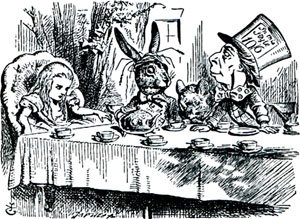The Madness Behind the Tea Party

Charles Dodgson was an English mathematician. He taught at Christ Church, a college which is part of the University of Oxford, from 1855 until retiring in 1881; he remained there in residence until his death in 1898. He was a capable teacher but, by most accounts, an uncreative thinker when it came to the boundaries of math. As the New Scientist noted, “even Dodgson’s keenest admirers would admit he was a cautious mathematician who produced little original work.” Dodgson believed in a logically rigorous approach to the exploration of the discipline which was grounded in reality, while many of his more avant garde counterparts were dreaming up concepts such as imaginary numbers (that is, what you get when you take the square root of a negative number).
Dodgson wasn’t too happy about that. So he wrote about it.
And you’ve probably read some of it, or at least watched the movie.
Charles Dodgson is better known by his pen name, Lewis Carroll. Carroll is the author of Alice’s Adventures in Wonderland (on which the 1951 animated Disney film, Alice in Wonderland, is based). You’re likely familiar with the hookah-smoking caterpillar, the Cheshire Cat, the White Rabbit, the Mad Hatter, the Queen of Hearts, and of course Alice herself. And you probably think that the story is a great, leading example of the genre of literary nonsense, which it is. But it is also likely Dodgson’s treatise against the newfangled math which threatened his worldview.
Let’s start with the Mad Hatter’s tea party. If you read the chapter (and if you need a copy, just click here), you’ll note that the Mad Hatter references “Time” as a being, not a thing:
`If you knew Time as well as I do,’ said the Hatter, `you wouldn’t talk about wasting it. It’s him.’
`I don’t know what you mean,’ said Alice.
`Of course you don’t!’ the Hatter said, tossing his head contemptuously. `I dare say you never even spoke to Time!’
By extension, that means Time isn’t at the table. The Mad Hatter and his two non-Alice guests, the Dormouse and March Hare, are therefore stuck at 6 PM, and it’s eternally tea time where they are. If you’re trying to be an absurdist, that’s a great way to get there — time isn’t something that can be simply added or removed. As a result, the Mad Hatter’s tea party is a heaping pile of nonsense — one that Alice finds so absurd that she storms off. The whole chapter makes no sense to either Alice nor the reader. And that is likely Dodgson’s point.
As it turns out, one of Dodgson’s contemporaries had developed a theory known as “quaternions.” The quaternion system took objects which exist in the typical three-dimensional coordinate plane and added a fourth factor, time, in order to allow the object to move and rotate within that space. Dodgson thought the whole thing was hogwash (it isn’t). As NPR reported, the tea party was an example of Dodgson’s wishes that we “get rid of all of this complexity in the first place, and [. . .] just go back to the familiar old geometry that we’ve had since Euclid for 2,000 years.”
There are other examples in Wonderland of Dodgson’s disdain for complex math, too. At one point, Alice tries to multiply, but ends up with odd results — four times five equals 12, four times six gives her 13, and four times seven is 14. That appears wrong, but that assumes Wonderland is a decimal-based universe. If math there is base-18, the number twenty (which is four times five) would be represented as one eighteen and two ones, or “12.” Similarly, twenty four would be represented as “13” in a base-21 system, and twenty eight is “14” in a base-24 system. That may be what Dodgson, who likely wasn’t fond of the idea that you could just change the system willy-nilly, intended. As io9 notes, “when you change the system of measurement, but keep thinking of it as the original standard, you can pile on the numbers and never get anywhere, leaving you as lost as Alice.”
In the end, all this “fake math” meant fame and fortune for Dodgson, although the fame part required him to become Lewis Carroll — that is, to adopt a fake name.
 Bonus Fact: The protagonist in Alice’s Adventures in Wonderland is likely named for Alice Liddle, the daughter of the Dean of Christ Church when Dodgson began teaching there. Dodgson would deny this later in life, but his writings give it away. There’s a poem titled “Life is But a Dream” toward the end of Through the Looking Glass, the sequel to Alice’s Adventures in Wonderland. (You can read it here.) The first words of each line spell out “Alice Pleasance Liddell.”
Bonus Fact: The protagonist in Alice’s Adventures in Wonderland is likely named for Alice Liddle, the daughter of the Dean of Christ Church when Dodgson began teaching there. Dodgson would deny this later in life, but his writings give it away. There’s a poem titled “Life is But a Dream” toward the end of Through the Looking Glass, the sequel to Alice’s Adventures in Wonderland. (You can read it here.) The first words of each line spell out “Alice Pleasance Liddell.”
From the Archives: Wonderland, On Ice: The Disneyland clone that almost was.
Take the Quiz: A Wonderland word ladder.
Related: “Alice’s Adventures in Wonderland,” the 70 page-long story.
